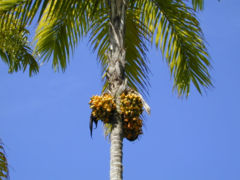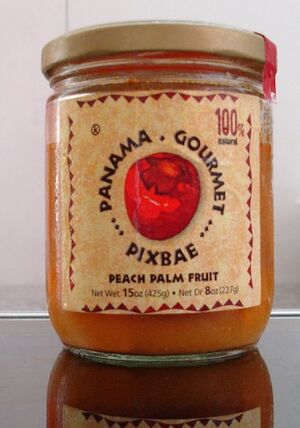Bactris gasipaes
| Bactris gasipaes subsp. var. | ||||||||||||||||||||||||||||||||||||||||||||||||||||||||
|---|---|---|---|---|---|---|---|---|---|---|---|---|---|---|---|---|---|---|---|---|---|---|---|---|---|---|---|---|---|---|---|---|---|---|---|---|---|---|---|---|---|---|---|---|---|---|---|---|---|---|---|---|---|---|---|---|

|
|
| ||||||||||||||||||||||||||||||||||||||||||||||||||||||
| ||||||||||||||||||||||||||||||||||||||||||||||||||||||||
| Standard Cyclopedia of Horticulture |
|---|
|
Bactris gasipaes, HBK. (Guilielma speciosa, Mart.). St. about 60 ft. high, single or cespitose, with rings of subulate-compressed black spines, 1 in. long, the rings about as far apart as the diam. of the st.: Lvs. 6 ft. long, curving; segms. dark green above, pale green below, very numerous, approximate, 1½ ft. long, 1¼ in. wide, linear-lanceolate, long-acuminate, bristly or minutely prickly along the margins: fr. orange or reddish, nearly 2 in. long, ovoid. Lower Amazon.
|
| Bactris gasipaes {{{status}}} Fossil range: {{{fossil_range}}}
| ||||||||||||||||||||||||||||||||||||||||||||||||||||||||||||||||||
|---|---|---|---|---|---|---|---|---|---|---|---|---|---|---|---|---|---|---|---|---|---|---|---|---|---|---|---|---|---|---|---|---|---|---|---|---|---|---|---|---|---|---|---|---|---|---|---|---|---|---|---|---|---|---|---|---|---|---|---|---|---|---|---|---|---|---|
 Bactris gasipaes palm | ||||||||||||||||||||||||||||||||||||||||||||||||||||||||||||||||||
| Plant Info | ||||||||||||||||||||||||||||||||||||||||||||||||||||||||||||||||||
| ||||||||||||||||||||||||||||||||||||||||||||||||||||||||||||||||||
| Scientific classification | ||||||||||||||||||||||||||||||||||||||||||||||||||||||||||||||||||
| ||||||||||||||||||||||||||||||||||||||||||||||||||||||||||||||||||
| [[{{{diversity_link}}}|Diversity]] | ||||||||||||||||||||||||||||||||||||||||||||||||||||||||||||||||||
| {{{diversity}}} | ||||||||||||||||||||||||||||||||||||||||||||||||||||||||||||||||||
| Binomial name | ||||||||||||||||||||||||||||||||||||||||||||||||||||||||||||||||||
| Bactris gasipaes Kunth | ||||||||||||||||||||||||||||||||||||||||||||||||||||||||||||||||||
| Trinomial name | ||||||||||||||||||||||||||||||||||||||||||||||||||||||||||||||||||
| {{{trinomial}}} | ||||||||||||||||||||||||||||||||||||||||||||||||||||||||||||||||||
| Type Species | ||||||||||||||||||||||||||||||||||||||||||||||||||||||||||||||||||
| {{{type_species}}} | ||||||||||||||||||||||||||||||||||||||||||||||||||||||||||||||||||
| {{{subdivision_ranks}}} | ||||||||||||||||||||||||||||||||||||||||||||||||||||||||||||||||||
| [[Image:{{{range_map}}}|{{{range_map_width}}}|]] | ||||||||||||||||||||||||||||||||||||||||||||||||||||||||||||||||||
| Synonyms | ||||||||||||||||||||||||||||||||||||||||||||||||||||||||||||||||||
| {{{synonyms}}} |
Bactris gasipaes is a species of palm native to the tropical forests of the South and Central America. It is a palm which can typically grow to 20 m or taller, with pinnate leaves 3 m long on a 1 m long petiole. The fruit is a drupe with an edible pulp surrounding the single seed, 4-6 cm long and 3-5 cm broad. The rind (epicarp) of this wild palm can be red, yellow, or orange when the fruit is ripe depending on the variety of the palm.

B. gasipaes is well known by the native populations where it usually grows up, and they having been used for centuries as food. They frequently eat the fruit stewed in salted water. However, it may be peeled and dressed with salt and honey, used to make compotes and jellies, or also used to make flour and edible oil.
Many species of birds feed on this wild palm, notably macaws, parrots and parakeets, all members of the family Psittacidae. Some of these are endemic species, which are in danger of extinction.
Because the huge importance of B. gasipaes for the native populations, there are numerous common names for this plant in several languages and many countries. For example, in English: peach-palm or pewa (Trinidad and Tobago), peyibay(e), and pejivalle; in Spanish: pejibaye (Costa Rica, Nicaragua), chontaduro or chantaduro (Colombia, Ecuador), pijuayo (Peru), pijiguao (Venezuela), tembé (Bolivia), pixbae (pronounced pibá) (Panama), and cachipay (Colombia); and in Portuguese: pupunheira, and pupunha (Brazil). In addition, there are several botanical synonyms, including Bactris ciliata (Ruiz & Pav.) Mart., B. insignis (Mart.) Baill., B. speciosa (Mart.) H. Karst., B. utilis (Oerst.) Benth. & Hook.f. ex Hemsl., Guilelma chontaduro Triana, G. ciliata (Ruiz & Pav.) H. Wendl., G. gasipaes (Kunth) L. H. Bailey, G. insignis Mart., G. speciosa Mart., G. utilis Oerst., and Martinezia ciliata Ruiz & Pav.

This plant may also be harvested for heart of palm, and has commercial advantages in being fast growing; the first harvest can be from 18 to 24 months after planting. In Brazil, it is a viable solution for the heart of palm cultivation industry because its agricultural characteristics are adequate for it to be beneficial to substitute it for other native palms such as species of Euterpe including Euterpe oleracea (known as açaí) and Euterpe edulis (known as juçara), that have been extensively exploited and are protected as endangered species. The Brazilian domestic market for heart of palm is about five times bigger than the external one; however, there is an increasing demand for this product internationally as it is increasingly used in international cookery. In addition, the cultivation of Bactris gasipaes is also economically important for Costa Rica.
- Composition of 100 g of pulp
164 calories, 2.5 g of protein, 28 mg of calcium, 31 mg of phosphorus, 3.3 mg of iron, 1,500 mmg of vitamin A, 0.06 mg of vitamin B1 and 34 mg of vitamin C.
- Pest Susceptibility
Mite (Tetranychus mexicanus), ant (Atta spp.), (Rhychophorus palmarum), (Strategus aloeus).
- Disease Susceptibility
Anthracnose (Colletotrichum gloesporioides), ascomycotic fungi (Helminthosporium sp.), (Phytophthora sp.), Mycosphaerella leaf spot disease (Mycosphaerella sp.), brown rot (Monilia sp.).
References and external links
- This text is based heavily on the corresponding article in the Portuguese Wikipedia, accessed on 29 March 2005.
- Schultes, Richard E. (1974). Palms and religion in the northwest Amazon. Principes 18 (1): 3-21. Astrocaryum vulgare, Bactris gasipaes, Euterpe oleracea, E. precatoria, Leopoldinia piassaba, Maximiliana martiana, Oenocarpus bacaba, Socratea exorrhiza
- Bactris gasipaes H.B.K.
- Peach-palm (Bactris gasipaes)
- Mora-Urpi, J., Weber, J., & Clement, C. R. Peach palm (Bactris gasipaeas).International Plant Genetic Resources Institute (pdf file).
- Chontaduro (Palm Fruit) Chontaduro uses, history and health benefits